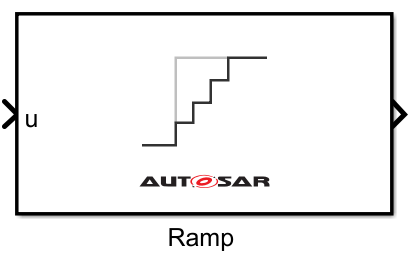Ramp
Generate signal that follows input value bound by rising or falling slope
Since R2023b
Libraries:
AUTOSAR Blockset /
Classic Platform /
Library Routines /
Math Operations
Description
The Mathematical Floating point Library (MFL) Ramp block generates a signal that starts at a specified value and changes by a specified rate until the value of the input signal is reached. The block parameters Rise slope, Fall slope, Initial condition, and Sample time, and the input signal u determine the characteristics of the output signal.
When you select the AUTOSAR 4.x Code Replacement Library (CRL) for your
AUTOSAR model, your model replaces code that you generate for this block with calls to the
following AUTOSAR library routines:
Mfl_Ramp_InitStateMfl_Ramp_SetParamMfl_RampCalcMfl_RampOut_f32
